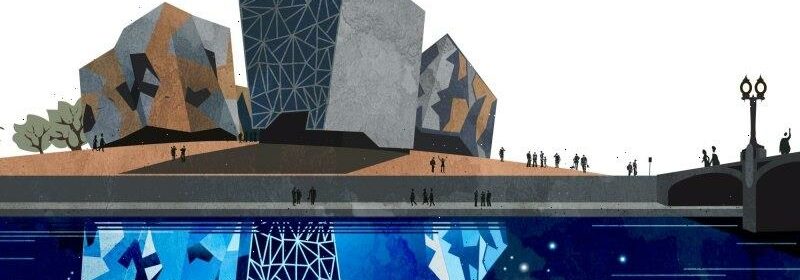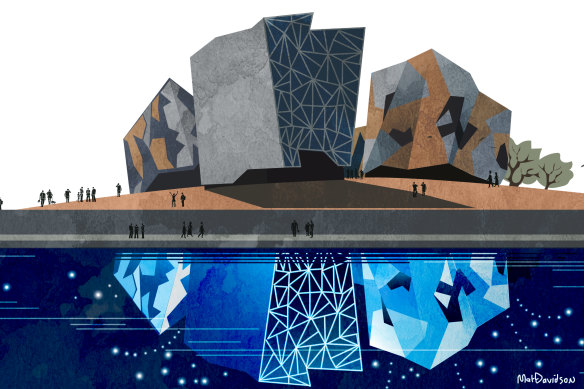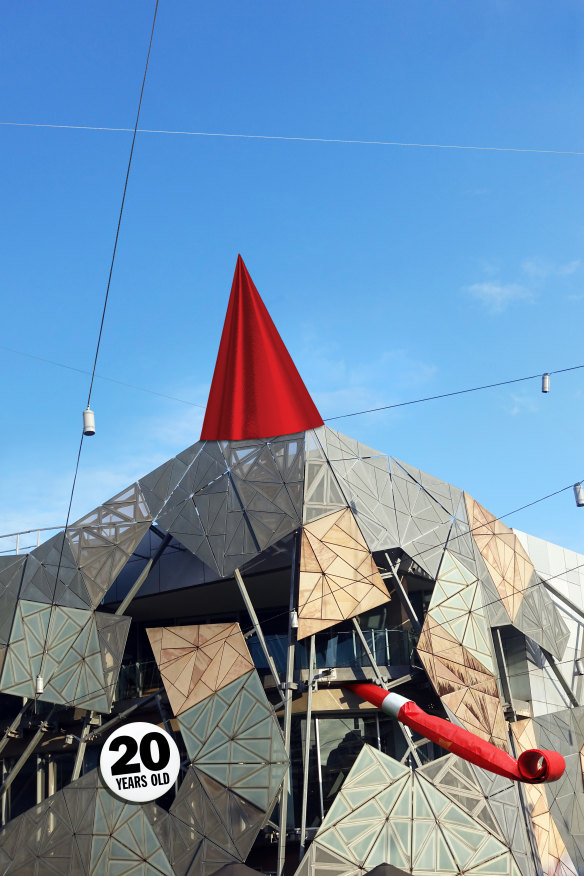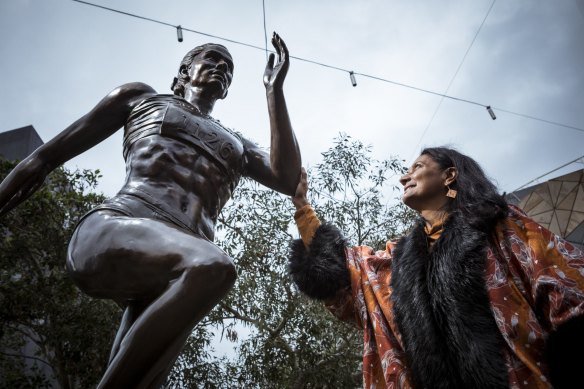Fed Square turns 20: Where do we stand on the city landmark now?

By Kerrie O'Brien
Illustration: Matt Davidson.Credit:
Controversial” is a word that comes up often in any search involving Fed Square. “Ugly”, “messy” and “inaccessible” also get a look-in, as do “fabulous” and “extraordinary”. But in the 20 years since Melbourne’s sprawling gathering place was created, other terms have entered the discussion. “Beloved” is one. “Beautiful” is another. The one that trumps them all, though, is “ours”. The outcry over plans to install an Apple store on the site in 2017 underlined how much the city’s so-called “gateway”, with its irregularly shaped “shards” and tiled piazza, had won us over. On the eve of its birthday on October 26, we asked leading Melburnians where they stand on the square.
Katrina Sedgwick, director and chief executive of Melbourne Arts Precinct Corporation
The cultural precinct including Federation Square on the banks of the Birrarung is where First Nations people have gathered for tens of thousands of years. It has always been a meeting place, a place of sharing stories. Even though the site was built over and turned into train yards, a morgue, a fish market and a few other unsightly structures, it’s no accident it’s a site of significance.
Before I moved to Melbourne, I was a regular visitor as a tourist; I loved coming to Federation Square, I found it a fascinating place – the architecture is utterly remarkable. I still can’t believe the vision and boldness of the Victorian government to support this unique, quite radical design. In 2015, I became a tenant, when I took on the role as director and chief executive of ACMI, the wonderful museum conceived as part of the fabric of the Square.
Credit:Judith Green
Victorian chief architect Jill Garner was saying recently that the Square is a remarkable and rare piece of deconstructivist architecture – one of the few examples in the world where a design was actually built rather than just a concept on paper.
So it is genuinely globally significant. It has got into the DNA of the people of Melbourne: initially some people were shocked by it, confronted by it, and it was unique. But over time, people embraced it, they gathered there, it very quickly became embedded as the town square.
The iconography of the architecture, that amazing geometry that plays out across the facades, the quite radical approach to the spatial, the way it takes these ideas of laneways and avenues and nooks and crannies reflects what Melbourne is, in interesting and unexpected ways. The uprising of emotion in the community with the recent proposal of housing the Apple store there underlined how passionate Melburnians are about it.
It’s the only 21st century building in the CBD on our heritage register. We should be immensely proud as a city and a state that a building of this kind has been created, and that it is going to be protected. We should be equally proud that it is so wonderfully inhabited by culture, housing ACMI, the Ian Potter Gallery and the Koorie Heritage Trust.
Now, of course, a new era begins because again the Victorian government has made this incredible investment into the Melbourne Arts Precinct Transformation, which is going to see – on the other side of the river – this crucial upgrade to the Arts Centre’s state theatre, the magnificent new NGV Contemporary and this precinct-changing public realm that will connect from Princess Bridge to Southbank Boulevard.
It’s a game-changer – off the back of the Fed Square review, really – to position it with its civic and cultural charter at its core. To bring Fed Square into that arts precinct and to think about how this amazing piece of architecture and the activity that happens within it – and around – is in fact the gateway to a broader arts precinct. That is hugely exciting; the potential is enormous.
We are expanding that with this amazing strategic investment that brings together this remarkable 20-year-old asset, with the cultural institutions contained within, on one side of the river, and connecting it to the other side of the river to do something utterly remarkable and to bring in a million more people each year.
Brian Nankervis, broadcaster, RocKwiz host
I’ve got a funny relationship with Fed Square: when it first opened I was excited there would be a new public meeting place for Melburnians, but my initial reaction to the topography was lukewarm – I wondered if it should be easier to walk on. Over the years, I have grown to really, really like it. I think it functions really well; I love the fact you can walk out of Flinders Street Station and be there in a minute, or walk down from the Arts Centre.
I’ve done a few shows on the stage at the Square, which have always been wonderful gatherings. The one I really remember, it might have turned me around, was put on by the Asylum Seeker Resource Centre in 2013, when they launched the Hot Potato Project via the Republic of Everyone.
Staged in the lead-up to the federal election, it was designed “to take the heat out of the conversation”, to debunk myths about asylum seekers. It centred around the hot potato van that travelled around Australia, providing food but designed to encourage conversations: you talk quite freely when you’ve got a baked potato in hand.
I shared the stage with people like Julian Burnside and the ASRC’s Jana Favero; Mark Seymour sang. Anglican Bishop Philip Huggins spoke with such eloquence about asylum seekers and about the debate, which at that stage was driven very much by fear, on the pretence of protecting our country.
Hanging high on St Paul’s Cathedral opposite us was this huge banner that said “Let’s fully welcome refugees”; it’s still there. I remember it being a sobering day but also positive. People in the audience felt the whole issue was a huge challenge but Julian Burnside suggested the idea of setting refugees up in rural and regional areas. People in the audience from those locations said they would welcome that scenario, so it ended up being this very positive and very uplifting experience.
I remember gathering there with my children for a Long Walk before Collingwood and Melbourne played at the MCG. Michael Long spoke and it was an incredible gathering of the tribes, a whole range of supporters, walking side by side, united in a common goal.
Nova Peris, former Olympian, founder of the Nova Peris Foundation
My relationship with Fed Square goes back to the Long Walk, that’s where for me it’s a standout. Michael Long is a dear friend of mine and in his absence, I’ve spoken a few times at the Long Walk, up on the stage with whichever PM we were churning through at the time, alongside a who’s-who of politics. From that perspective, it brings people together; it’s almost like the meeting place for reconciliation.
The impact the Koorie Heritage Trust has made is also significant … they do magnificent tours along the Birrarung and the events they have leading to Tanderrum are amazing.
Apart from the bricks and the mortar, it’s a significant meeting place with culture always at the forefront, not just First Nations culture but many other cultures and events. I launched I’ll stand with you, a short film I co-produced with Matt Norman, there. It is based on Australian athlete Peter Norman who stood with his fellow winners on the podium, the two Americans making the Black Power salute and Peter wearing his badge showing his solidarity with them, at the 1968 Olympics in Mexico City. Fed Square is also committed to community support, hosting cultural events and things like our film, for a greater good – that really stands out for me.
Nova Peris unveils the statue of her likeness at Federation Square in 2021.Credit:Chris Hopkins
My statue being launched there in July last year was amazing. The number of people who have sent photos – and when I’ve been back in Melbourne on site I’ve watched little kids climb over it and people taking it in – that’s a really nice feeling. My statue is being moved on but will remain part of the precinct, to sit at the Princes Walk along the Yarra River. Shout out to artists Gilly and Marc of Statues for Equality who made the bronze work; I feel that this is an opportunity to push for more statues of different cultural backgrounds – statues tell a story and a history, that’s what Statues For Equality stand for.
Professor Rob Adams, city architect
Federation Square was controversial from its inception. Conceived initially by the city as the Centenary Centre for Federation, the concept, comprising a large greenhouse and public square, was to provide Melbourne with a new civic gateway and grand public space. When the idea was put to the then premier Jeff Kennett, his blunt response was, “I don’t like your proposal but I accept the intent”.
It was agreed by the state and the city that the project should be delivered jointly through an international design competition. The winning design produced a bold complex of stone faceted buildings dissected by lanes, leading through to a central sloping square. This design also controversially broke with the brief by partly building a section in front of the St Paul’s Cathedral. Late in the competition process, the initial schedule of accommodation was expanded to include a new gallery, which had not been budgeted for. The result was that the project was seen as disrespectful to the Cathedral and, unfairly, as grossly over budget.
Twenty years later much of the controversy has faded and Melbourne has this iconic and much-loved gateway, in concert with the unlikely bedfellows of Flinders Street Station, Young and Jacksons pub, and the Cathedral.
The gateway has worked but the Square has yet to reach its full potential. Good city squares are a product of the activities that surround them: the limited hospitality and introverted buildings that surround Federation Square result in the space needing to be continually programmed at significant cost. The brief visit of Joost Bakker’s Greenhouse, in 2008, in the gap beside SBS, was an indicator of what may be required if the Square is to ever have the 24/7 pulsing energy of other world squares, without depending on expensive programming.
It would also benefit Federation Square if it had better links to the Yarra River, as was originally proposed in the winning design but omitted due to budget constraints.
Virginia Trioli, broadcaster and journalist
I remember covering the first design of Fed Square as a journalist for The Age, dutifully reporting the howls of outrage by the rest of the architectural community, who just thought it was an absolute mess, a dog’s breakfast of shards and objects and scatterings. I remember one very well-known architect who I won’t name who said, “It hasn’t even opened and already it looks dated.”
Notwithstanding the criticisms – and I have my own criticisms of it as a design space – the other side of that is the idea, ‘If you build it, they will come’. I remember that original City Square, it was just a crappy open space and yet, bless us, we would still gather there.
I always thought it was a glorious thing that everyone would gather at Fed Square, without any notification; it was a drawcard and spoke to our desire to come together. I’m a big walker and I always like walking through there on a warm day.
My other memory of it was a morning in the early days of ABC News Breakfast, looking up and seeing [the show] screening at Fed Square. I remember thinking “we’ve made it” because we were on the big screen there. That was in the early days when no one was watching News Breakfast – I’m not sure who it was, so whoever in Fed Square central, shout out to you.
It missed a massive opportunity to be opened down to the river, the reimagining that’s going on that seems to turn the Square to the river is not only brilliant but fundamental to making it a more inviting space.
Tom Mosby, chief executive, Koorie Heritage Trust
The Koorie Heritage Trust took up residency in the Yarra Building at Federation Square in 2015, coinciding with our 30-year birthday celebrations. It marked a significant milestone for the Trust, as well as for the Square, the City of Melbourne and, more broadly, Victoria.
Our position at such a site recognises the importance of First Nations people as central to both historical and contemporary Melbourne. It also places the Trust as the third pillar of the Fed Square cultural landscape, alongside NGV Australia and ACMI. We are the only Aboriginal cultural centre in the country that has such a central location.
Fed Square has been important in the revival of traditional practices, specifically the Tanderrum, part of the opening ceremony of the Melbourne Festival in 2013. A gathering of the five Aboriginal clans of the Kulin nation, Tanderrum had not been practised in Melbourne since 1835. It not only acknowledged the significance of the site as a gathering place for the Kulin Nation, but it as a contemporary gathering place for Melbourne and the broader Victorian community.
Robyn Archer, singer, writer, director
In 2002, I was directing the Melbourne Festival and my offices were two or three floors up on Flinders Street, opposite the construction site. From that vantage point, I could see when all the work started and stopped, when the floodlights went on and they worked all night to get it done; it was a very exciting process. At that time, there was a lot of discussion about whether people liked it or not.
The Square wasn’t quite ready for my first Melbourne Festival in 2001, the barriers were still up. Even so, we featured a work just outside the barriers, called Knot at Home by Bighart, about homelessness. There was a big double bed, manned by young homeless people 24 hours a day throughout the festival, and at various times celebrities and other VIPs would get into the bed and do an interview about homelessness. Scott Rankin and his team pulled together all the information they got from those interviews, and created a work that was then staged at the Capitol Theatre.
In November, when the barriers came away, I saw the people of Melbourne flood into the Square and make it their own; it was absolutely dramatic. Without question, people looked at it as their public piazza, instantly in there, enjoying the spaces, meeting others and embracing it.
I did a trio of Melbourne Festivals (Text, Body, Voice) and in the second one we hosted Dancing in the Square – every night, somebody got up on the stage and taught the crowd a different style. At the very first one it was the first time the Square had been used in this way: probably 3000-4000 people, we were being taught a modified version of Gene Kelly’s dancing routine from Singin’ in the Rain.
Melbourne Festivals had traditionally been doomed to be rained out because of the time of year they were staged; we were tempting fate but all we got that year was the slightest of showers and a fabulous rainbow. I just remember all these people with their arms outstretched doing the little dance and singing in unison, “We’re singing and dancing in the rain.” I remember people calling mates in Sydney saying, “You’ve got to get down here, Melbourne is going off.” Every night there was a new routine to be learnt, so we had 17 nights of people dancing in Fed Square. It was such a great opportunity and really brought the festival to life, this big outdoor participation.
Further than that, I saw a genuine public piazza: RMIT students would walk down Swanston Street from RMIT to graduate in Federation Square; Michael Long’s Long Walk started there and headed to the MCG; the apology by then Prime Minister Kevin Rudd to our First Nations people screened there, to a large crowd showing solidarity. People had a place to gather and celebrate community.
In 2006 or 2007, Kate Brennan invited me to create a winter festival for Fed Square in the month of June, which went for a decade, called the Light in Winter; it pre-dated [Sydney’s] Vivid by years. She also insisted it involve Melbourne’s community; she really wanted that community touchstone as well.
What I learnt was that Fed Square was a beautiful place to program the arts because you were programming not for the main spaces but for cracks between the spaces, all sorts of little nooks and crannies, where you could host more intimate shows. It is wonderful to be able to create using not just prescribed, performative gallery spaces, but also the other spaces: that’s a wonderful challenge and makes programming there a joy.
What we were doing in Fed Square and what the Square was capable of hosting was this very diverse community-based work alongside global arts heroes like Rafael Lozano-Hemmer, who raised a giant sun over the Square. Some people make this distinction, that it’s an either/or scenario, high art or community, but we proved clearly you can always have both. Not only is it a space for art but a civic space for wider culture, including sport, food and political events. I see Fed Square as having enormous potential: it’s a superb gathering space and we’re lucky to have it.
Daniel Crooks, artist
I started at ACMI as the motion graphics designer about six months before the museum and the Square opened, so I really got to see it when it was still a construction site. As always, there was a bit of blowback against contemporary architecture but there was a genuine feeling of anticipation, and the access to the river was great. When the Six Degrees bar Riverland opened right on the Yarra, that was a key moment as well.
Back then, we were all thinking about what ACMI might be, all very idealistic and utopian. Jane Ellery and I were the media design team, working with amazing curators like Alexie Glass-Kantor, Emma Crimmings, Rhys Graham and Christos Tsiolkas.
Victoria Lynn’s show Deep Space was pretty epic, Mike Stubbs’ White Noise was absolutely pivotal and remarkable. Another personal highlight was the Christian Marclay show Replay Marclay, and later, The Clock in 2008: huge numbers of people came along and it was great to think that the public was getting a pretty interesting moving image contemporary art experience.
As well as working at ACMI, I had my own art practice, I’ve shown a few times there; the organisation as a whole was incredibly supportive of me as an artist working with the moving image. The curators internally were amazing but I also go to meet and work with travelling curators, artists and assistants, as they were working in the gallery: an incredible opportunity. The equipment and access to computers, video machines – pretty serious hardware – that as an artist you don’t have any access to without huge funding was a game-changer. It meant I could experiment in ways I simply wouldn’t have been able to otherwise.
Motion graphics is pretty standard now, the kids are pumping out mad stuff on their phones but back then, I had to explain to people what I was doing. DVD had just been introduced so being able to present video art became much more doable: you could quite economically produce something and put it onto a cheap player and it would loop all day and be presentable.
In the early 2000s, we crossed this threshold – kids like me could take the crazy things that we were making with our cameras and our computers, and disseminate them. There was no YouTube, no Instagram, but you could buy a DVD player for a couple of hundred bucks, so we could burn our own DVDs and put them out there. It was super exciting – it’s completely unfathomable now. For the first time we could put our work in a gallery, which had really not been possible until then.
Events marking Fed Square’s 20th birthday continue till October 31. fedsquare.com/events/20th-anniversary
A cultural guide to going out and loving your city. Sign up to our Culture Fix newsletter here.
Most Viewed in Culture
Source: Read Full Article


